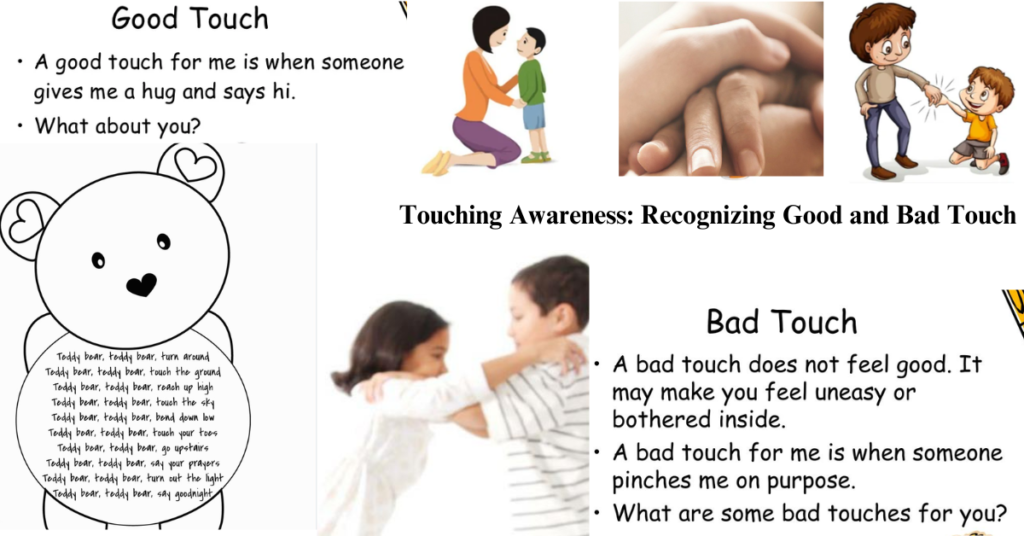“Touching Awareness: Recognizing Good and Bad Touch” emphasizes understanding the difference between safe, caring touch and uncomfortable, inappropriate touch, empowering individuals to protect their boundaries and well-being.

Touching Awareness: Recognizing Good and Bad Touch
Touching Awareness programs on good touch and bad touch are vital for reintroducing the healing power of touch into our lives. By educating the public, promoting mindfulness, and enhancing social cohesion, these programs can make a profound impact on individual and community health. {Sparsh} touch reminds us that in a world increasingly driven by virtual interactions, the simple act of touch remains a powerful tool for connection and healing. Through these awareness initiatives, we can cultivate a more compassionate, connected, and healthier society.
Table of Contents
Touching Awareness: Recognizing Good and Bad Touch
RecognizingGood Touch and Bad Touch are concepts used to help children differentiate between appropriate and inappropriate physical contact.

Good Touch:
- Definition: A touch that makes someone feel safe, comfortable, and loved. It is consensual, respectful, and suitable for the context of the relationship.
- Examples:
- A hug from a parent or family member
- A handshake or high-five with a friend
- A pat on the back from a teacher or coach
- Holding hands with a trusted adult when crossing the street
Bad Touch:
- Definition: A touch that makes someone feel uncomfortable, scared, or violated. It is non-consensual, disrespectful, and inappropriate, often crossing personal boundaries.
- Examples:
- Touching private parts of the body without consent
- Any touch that feels too rough or invasive
- Touches meant to be secretive or cause shame
- Any physical contact that makes a person feel uneasy or afraid
Importants things to Remember Recognizing Good and Bad Touch:
- Your body belongs to you, and you have the right to refuse any touch that feels wrong.
- Always trust your feelings—if a touch feels bad or uncomfortable, it likely is.
- It is important to tell a trusted adult if someone touches you in a way that makes you feel bad.
- Good touch respects boundaries and is always consensual. Bad touch disrespects boundaries and is never okay.
Small story on Recognizing Good and Bad Touch
In the vibrant village of Anantpur, children gathered every evening in the community center for storytelling sessions led by Asha, a wise and kind-hearted woman known for her engaging tales and gentle demeanor. Among the eager listeners was Rani, a bright-eyed girl with an insatiable curiosity.
One day, Asha began her session with a story about a butterfly and a bumblebee. The children, intrigued, leaned in closer.
“Once upon a time, in a beautiful garden,” Asha started, “there lived a delicate butterfly named Bela and a busy bumblebee named Buzz. They both loved to visit flowers, but their ways of touching the flowers were very different.”
“Bela would gently land on the flowers, her soft wings barely brushing the petals. The flowers felt happy and safe with her touch. They opened up wider, allowing Bela to enjoy their sweet nectar. Buzz, however, sometimes forgot to be gentle. He would land heavily, causing the flowers to close up in fear and discomfort.”
Asha paused, letting the children visualize the scene. “One day, a wise old flower spoke to Buzz. ‘Buzz, your touch can be gentle too, just like Bela’s. When you are gentle, we feel safe and happy.’ Buzz listened and learned to touch the flowers softly, just like Bela.”
The children smiled, enjoying the story, but Asha knew it was time to delve deeper into the lesson. “You see, my dear children, Bela’s touch was a ‘good touch’ because it made the flowers feel safe and happy. Buzz’s touch, when it was too rough, was a ‘bad touch’ because it made the flowers feel scared and uncomfortable.”
Rani raised her hand, “Asha, what about people? How do we know if a touch is good or bad?”
Asha nodded, appreciating Rani’s thoughtful question. “Good touch makes us feel loved, safe, and comfortable. It’s a hug from a parent, a high-five from a friend, or a pat on the back from a teacher. Bad touch, however, makes us feel scared, uncomfortable, or confused. It’s important to remember that your body belongs to you, and you have the right to say ‘no’ to any touch that doesn’t feel right.”
She continued, “If someone touches you in a way that makes you feel bad, tell a trusted adult immediately. Never keep it a secret, because you deserve to feel safe and happy, just like the flowers in the garden.”
The children listened intently, understanding the gravity of Asha’s words. Rani felt a sense of empowerment, knowing that she had the right to speak up and protect herself.
As the session ended, Asha reminded them, “Always remember Bela and Buzz. Be gentle and kind like Bela, and don’t be afraid to speak up like the wise old flower. Your safety and happiness are important.”
With that, the children left the community center, carrying the lesson of good and bad touch in their hearts. And Rani, with her newfound understanding, felt more confident and ready to navigate the world with wisdom and courage.

Conclusion on Recognizing Good and Bad Touch
Touching Awareness: Recognizing Good and Bad Touch.”Good Touch and Bad Touch” underscores the vital role of educating children about appropriate physical contact. By comprehending the distinction between safe, caring touch and uncomfortable, inappropriate touch, children gain empowerment to assert their boundaries and seek assistance when necessary. Through open communication and guidance from trusted adults, we can establish a safer and more respectful environment for all children, fostering a culture of empathy, understanding, and protection. Let us persist in promoting awareness and vigilance to safeguard the well-being of our children, ensuring that every touch is one of kindness and respect.


